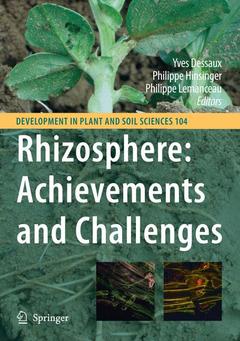Rhizosphere: Achievements and Challenges, 2010 Developments in Plant and Soil Sciences Series, Vol. 104
Coordonnateurs : Dessaux Yves, Hinsinger Philippe, Lemanceau Philippe

Described by Hiltner over a century ago (1904), the rhizosphere is defined as the fraction of soil influenced by plant root activities. This dynamic, complex interface where soil, plant roots and microbes interact is a major hotspot of microbial activity, where numerous subtle molecular processes, as well as multiple feedback events take place, Rhizosphere investigations at the microscopic scale have driven spectacular academic advances in the fields of soil sciences or plant-microbe interactions. They bear promises in terms of environmentally-friendly procedures such as bioremediation or ecological engineering. The long recognized role of rhizosphere processes in plant nutrition and health, and more generally in plant adaptation to stress conditions, is now becoming central for designing sustainable management practices of agricultural and forest ecosystems. The rhizosphere, however, must also be considered and investigated at a much larger scale than its own, especially as a location where important steps of both carbon and nitrogen cycles occur, with obvious links with global changes. Major advances in understanding the rhizosphere have been achieved over the last two decades. Combined expertise in plant biology, microbial ecology and soil sciences and design of research strategies including the latest innovative methods in these fields opens exciting prospects for the future.
Rhizosphere: so many achievements and even more challenges, Dessaux; Carbon flow in the rhizosphere: carbon trading at the soil-root interface, Jones; Nitrogen-fixing bacteria associated with leguminous and non-leguminous plants, Elmerich; Biochemical cycling in the rhizosphere having an impact on global change, Philippot; Plant-microbe-soil interactions in the rhizosphere: an evolutionary perspective, Lambers; Rhizosphere: biophysics, biogeochemistry and ecological relevance, Hinsinger; Plant Root Growth, Architecture and Function, Hodge; The rhizosphere zoo: An overview of plant-associated communities of microorganisms, including phages, bacteria, archaea, and fungi , and of some of their structuring factors, Jurkevitch; Rhizosphere fauna: the functional and structural diversity of intimate interactions of soil fauna with plant roots, Bonkowski; Plant-driven selection of microbes, Schmid; Rhizosphere microbiota interfers with plant-plant interactions, Duponnois; Molecular communication in the Rhizosphere, Faure; Acquisition of phosphorus and nitrogen in the rhizosphere and plant growth promotion by microorganisms, Richardson; The rhizosphere: a playground and battlefield for soilborne pathogens and beneficial microorganisms, Raaijmakers; Rhizosphere engineering and management for sustainable agriculture, Dessaux; Rhizosphere processes and management in plant-assisted bioremediation (phytoremediation) of soils, Wenzel; Novel approaches in plant breeding for rhizosphere-related traits, Wissuwa; Strategies and methods for studying the rhizosphere - The plant science toolbox, Neumann; Sampling, defining, characterising and modeling the rhizosphere - The soil science tool box, Luster; Molecular tools in rhizosphere microbiology - from single-cell to whole-community analysis, Sorensen; Iron dynamics in the rhizosphere as a case study for analyzing interactions between soils, plants and microbes, Lemanceau.
Date de parution : 12-2009
Ouvrage de 536 p.
19.3x26 cm



